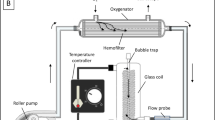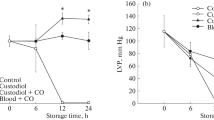Summary
The changes in the status of the adenylic acid-creatine phosphate system and in glycogen, glucose, and lactate were investigated in canine kidneys during preservation in anaerobic and aerobic ischemia at normo- and hypothermia. For anaerobic ischemia, the kidneys were stored without additional measures; for aerobic ischemia, the ischemic kidneys were persufflated with gaseous O2 or gas mixtures containing O2 via the renal artery or vein (orthograde and retrograde aerobic ischemia respectively). Prior to preservation, the kidneys were flushed with cell-free perfusates.
Changes in the metabolic status characteristic of anaerobic ischemia were a decrease in the tissue levels of ATP, creatine phosphate, glycogen, glucose, and the sum of adenine nucleotides, a transitory increase in ADP and AMP, and an increase in the tissue level of lactate. Hypothermia caused a retardation of the anaerobic alterations; the loss of ATP was slowed down by factors of 2 and 9.5 when the temperatures were lowered from 37° to 26° and 6°C, respectively.
In aerobic ischemia with orthograde and retrograde persufflation of 100% O2 (persufflation pressure = PP 60 and 30 mm Hg), deviations from a regular metabolic status developed very slowly. While the ATP-level decreased to 50% of the control value within scarcely 30 min of anaerobic ischemia at 6°C, it was almost 48 h before a similar loss of ATP occurred during orthograde aerobic ischemia at 6°C. Reduction of O2 in the persufflation gas to 40 and 21 vol-% resulted in less adequate preservation of the metabolic status. Increasing PP to 100 mm Hg for orthograde persufflation had no effect. An increase in PP to 60 mm Hg for retrograde persufflation resulted in a further delay in the metabolic deterioration. The long-term preservation of a regular metabolic status or the slow deviation of the metabolic pattern from the normal range during ischemia with O2-persufflation indicates a significantly smaller energy deficit than during storage in anaerobic ischemia. It must be attributed to a sufficient aerobiosis in the aerobically ischemic kidney, during which organogenic substrates brought in by the initial perfusion are utilized.
Similar content being viewed by others
References
Arnold, G.: Verlängerung der nutzbaren Ischämiedauer des Herzens durch Erhöhung des äußeren O2-Partialdruckes und Persufflation der Coronargefäße mit gasförmigem Sauerstoff. Langenbecks Arch. klin. Chir.319, 641 (1967).
Arnold, G., Müller-Ruchholtz, E. R., Lochner, W.: Die Persufflation der Koronargefäße mit gasförmigem Sauerstoff zur Verlängerung der Ischämiedauer des Herzens. Ärztl. Forsch.22, 257 (1968).
Bunzl, A., Burgen, A. S. V., Burns, B. D., Pedley, N., Terroux, K. G.: Methods for studying the reflex activity of the frog's spinal cord. Brit. J. Pharmacol.9, 229 (1954).
Burns, B. D., Robson, J. G., Smith, G. K.: The survival of mammalian tissues perfused with intravascular gas mixtures of oxygen and carbon dioxide. Canad. J. Biochem.36, 499 (1958).
Busch, E. W., Borcke, I. M. von, Martinez, B.: Abbauwege und Abbaumuster der Purinnucleotide in Herz-, Leber- und Nierengeweben von Kaninchen nach Kreislaufstillstand. Biochim. biophys. Acta (Amst.)166, 547 (1968).
Camishion, R. C., Davies, A. C., Tokunaga, K., Solit, R. W.: Retrograde perfusion of the coronary arteries with gaseous oxygen during cardiopulmonary bypass. Surgery59, 145 (1966).
Chinard, F. P., Goresky, C. A., Nolan, M. F.: Renal transit times and distribution volumes of T 1824, creatinine and water. Amer. J. Physiol.209, 243 (1965).
Chinard, F. P., Taylor, W. R., Nolan, M. F., Enns, T.: Renal handling of glucose in dogs. Amer. J. Physiol.196, 535 (1959).
Denecke, H., Isselhard, W., Stelter, W., Berger, M., Sachweh, D.: Recovery of the kidney from aerobic and anaerobic ischemia in deep hypothermia. Europ. Surg. Res.3, 182 (1971).
Denecke, H., Isselhard, W., Stelter, W., Berger, M., Sachweh, D., Lauschke, H.: Nierenstoffwechsel und-funktion während und nach anaerober und aerober Ischämie in Hypothermie in situ. Langenbecks Arch. klin. Chir.329, 967 (1971).
Dies, F., Herrera, J., Matos, M., Avelar, E., Ramos, G.: Substrate uptake by the dog kidney in vivo. Amer. J. Physiol.218, 405 (1970).
Gabel, L. P., Bihler, J., Dresel, P. E.: Contractility, metabolism and pharmacological reactions of isolated, gas-perfused cat hearts. Circulat. Res.19, 891 (1966).
Gärtner, K.: Das Volumen der interstitiellen Flüssigkeit der Niere bei Änderungen ihres hämodynamischen Widerstandes; Untersuchungen an Kaninchen. Pflügers Arch. ges. Physiol.292, 1 (1966).
Gerlach, E., Bader, W., Schwoerer, W.: Über den Stoffwechsel säurelöslicher Phosphor-Verbindungen in der Rattenniere. Pflügers Arch. ges. Physiol.272, 407 (1961).
Gerlach, E., Deuticke, B., Dreisbach, R. H.: Zum Verhalten von Nucleotiden und ihren dephosphorylierten Abbauprodukten in der Niere bei Ischämie und kurzzeitiger post-ischämischer Wiederdurchblutung. Pflügers Arch. ges. Physiol.278, 296 (1962).
Grupp, G., Hierholzer, K.: Der O2-Verbrauch von Nierengewebe verschiedener Zonen. Z. Biol.109, 197 (1957).
Hähn, N.: Zerfall energiereicher Phosphate und Milchsäurebildung im normound hypothermen Myokard des Hundes bei sogenanntem ischämischen Herzstillstand und der Kardioplegie durch extracellulären Natrium- und Calciumentzug und Procaingabe. Dissertationsschrift, Köln 1967.
Hanson, R. W., Lindsay, R. H., Barker, S. B.: Effect of thyroxine on metabolism of glucose and amino acids by rat kidney cortex. Endocrinology69, 883 (1961).
Huang, G. S., Downes, G. L., Belzer, F. O.: Utilization of fatty acids in perfused hypothermic dog kidneys. J. Lipid. Res.12, 622 (1971).
Isselhard, W.: Akuter Sauerstoffmangel und Wiederbelebung. Dtsch. med. Wschr.90, 349 (1965).
Isselhard, W.: Acute aroxia and resuscitation. Germ. Med. Mth.10, 194 (1965).
Isselhard, W.: Maßnahmen zur Verbesserung der Erholung des Herzens nach Anaerobiose. Langenbecks Arch. klin. Chir.319, 665 (1967).
Isselhard, W.: Effects of prenylamine on the metabolic state in various organs and on cardiac function. Biochem. appl. XIV, Suppl.1, 345 (1968).
Isselhard, W., Berghoff, W., Schüler, H. W., Apostolopoulos, C.: Temperaturabhängigkeit der Änderungen im Stoffwechselstatus des künstlich stillgestellten anaeroben Herzens. Z. ges. exp. Med.145, 30 (1968).
Isselhard, W., Denecke, H., Stelter, W., Berger, M., Sachweh, D., Witte, J., Fischer, J. H.: Function and metabolism of canine kidneys after aerobic ischemia by orthograde persufflation with gaseous oxygen (In Preparation.)
Isselhard, W., Denecke, H., Witte, J., Berger, M., Fischer, J. H.: Renale Funktion nach hypothermer Nierenischämie mit orthograder und retrograder O2-persufflation in situ. Res. exp. Med.157, 231 (1972).
Isselhard, W., Mäurer, W., Stremmel, W., Krebs, J., Schmitz, H., Neuhof, H., Esser, A.: Stoffwechsel des Kaninchenherzensin situ während Asphyxie und in der post-asphyktischen Erholung. Pflügers Arch.316, 164 (1970).
Isselhard, W., Merguet, H.: Metabolite des Glykolyse-Cyclus und des Adenylsäure-Phosphokreatin-Systems im schlagenden und durchblutenden Warmblüterherzen unter verschiedenen Versuchsbedingungen. Pflügers Arch. ges. Physiol.276, 211 (1962).
Isselhard, W., Merguet, H., Palm, K.: Bestimmung des Gesamtglykogens neben säurelöslichen Metaboliten in Perchlorsäure-Organhomogenaten. Z. ges. exp. Med.136, 174 (1962).
Isselhard, W., Pohl, W., Berghoff, W. J. W., Schmerbauch, D., Schüler, A. W.: Versuche zur Verbesserung der Energiebereitstellung im künstlich stillgestellten Herzen und in der Erholung bei Reperfusion. Verh. dtsch. Ges. Kreisl.-Forsch.30, 216 (1964).
Isselhard, W., Witte, J., Denecke, H., Berger, M., Fischer, J. H., Molzberger, H.: Funktion und Stoffwechsel der Hundeniere nach aerober Ischämie durch retrograde Persufflation mit gasförmigem Sauerstoffin situ. (In Preparation).
Kean, E. L., Adams, P. H., Winters, R. W., Davies, R. E.: Energy metabolism of the renal medulla. Biochim. biophys. Acta (Amst.)54, 474 (1961).
Kramer, K., Thurau, K., Deetjen, P.: Hämodynamik des Nierenmarks. I. Capilläre Passagezeit, Blutvolumen, Durchblutung, Gewebshämatokrit und O2-Verbrauch des Nierenmarks in situ. Pflügers Arch. ges. Physiol.270, 251 (1960).
Lannon, S. G., Tukaram, K. T., Oliver, J. A., Mac Kinnon, K. J., Dossetor, J. B.: Preservation of kidneys assessed by a biochemical parameter. Surg. Gynec. Obstet.124, 999 (1967).
Lee, J. B., Vance, V. K., Cahill, G. F., Jr.: Metabolism of C14-labeled substrates by rabbit kidney cortex and medulla. Amer. J. Physiol.203, 27 (1962).
Levy, M. N.: Uptake of lactate and pyruvate by intact kidney of the dog. Amer. J. Physiol.202, 302 (1962).
Lochner, W., Arnold, G., Müller-Ruchholtz, E. R.: Metabolism of the artifically arrested heart and of the gas-perfused heart. Amer. J. Cardiol.22, 299 (1968).
Magnus, R.: Die Tätigkeit des überlebenden Säugetierherzens bei Durchströmung mit Gasen. Naunyn-Schmiedebergs Arch. exp. Path. Pharmak.47, 200 (1902).
Molzberger, H., Witte, J., Fischer, J. H., Castrup, H. J., Isselhard, W.: Limits of renal preservation by O2-persufflation at 36° and 6°C. (In Preparation.)
Müller-Ruchholtz, E. R., Arnodl, G., Miessner, E., Lochner, W.: Metabolitgehalt und Herzarbeit bei Durchströmung der Coronargefäße mit gasförmigen und flüssigen Medien. Pflügers Arch. ges. Physiol.294, R4 (1967).
Needleman, P., Passonneau, J. V., Lowry, O. H.: Distribution of glucose and related metabolites in rat kidney. Amer. J. Physiol.215, 655 (1968).
Nieth, H., Schollmeyer, P.: Substrate-utilization of the human kidney. Nature (Lond.)209, 1244 (1966).
Sabiston, D. C., Talbert, J. L., Riley, L. H., Blalock, A.: Maintenance of the heart beat by perfusion of the coronary circulation with gaseous oxygen. Ann. Surg.150, 361 (1959).
Sachweh, D., Eigler, F. W.: Comparison of energy-rich metabolism in rat kidneys during different preservation methods. Europ. surg. Res.3, 265 (1971).
Schirmer, H. K. A.: The effect of intermittent and prolonged renal artery occlusion upon respiration and anaerobic glycolysis of dog kidney. J. Urol. (Baltimore)94, 511 (1965).
Schmerbauch, D.: Wiederaufbau der Adeninnucleotide im isolierten Herzen bei Angebot von Substrat und Katecholaminen nach künstlichem Herzstillstand. Dissertationsschrift, Köln 1967.
Söling, H. D., Schmidt, L.: Vergleichende Untersuchungen des Sauerstoff-verbrauchs und der Bearbeitung von Glucose, Milchsäure und Brenztraubensäure im Stoffwechsel der Hundeniere. Naunyn-Schmiedebergs Arch. exp. Path. Pharmak.240, 140 (1960).
Talbert, J. C., Rhey, L. H., Sabiston, D. C., Blalock, A.: An evaluation of gaseous oxygen perfusion as a method for maintaining renal viability during periods of complete ischemia. Surg. Gynec. Obstet.112, 593 (1961).
Talbert, J. L., Rily, L. H., Sabiston, B. C., Blalock, A.: Retrograde perfusion of the coronary sinus with gaseous oxygen. Amer. J. Surg.26, 189 (1960).
Thorn, W., Isselhard, W., Müldener, B.: Glykogen-, Glucose- und Milchsäuregehalt in Warmblüterorganen bei unterschiedlicher Versuchsanordnung und anoxischer Belastung mit Hilfe optischer Fermentteste ermittelt. Biochem. Z.331, 545 (1959).
Thorn, W., Liemann, F.: Metabolitkonzentrationen in der Niere und Paraaminohippursäureclearance nach akuter Ischämie und in der Erholung nach Ischämie. Pflügers Arch. ges. Physiol.273, 528 (1961).
Voss, R., Ruile, K., Vogel, W., Kunz, W.: Untersuchungen zur Ischämietoleranzzeit der Nieren. Klin. Wschr.48, 1089 (1970).
Voss, R., Schoen, H. R., Ruile, K.: Stoffwechselverhalten der Niere während Ischämie. Folgerungen für die Organkonservierung. Z. ges. exp. Med.143, 255 (1967).
Wichert, P. v.: Enzymatische Bestimmung vonl-α-Glycerophosphat in normalen und belasteten Warmblüterorganen. Biochem. Z.336, 49 (1962).
Author information
Authors and Affiliations
Additional information
Supported by a grant from the Deutsche Forschungsgemeinschaft in the Sonderforschungsbereich 68.
Rights and permissions
About this article
Cite this article
Isselhard, W., Berger, M., Denecke, H. et al. Metabolism of canine kidneys in anaerobic ischemia and in aerobic ischemia by persufflation with gaseous oxygen. Pflugers Arch. 337, 87–106 (1972). https://doi.org/10.1007/BF00587833
Received:
Issue Date:
DOI: https://doi.org/10.1007/BF00587833




